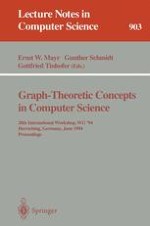1995 | ReviewPaper | Chapter
Cartesian products of graphs as spanning subgraphs of de Bruijn graphs
Extended abstract
Authors : Thomas Andreae, Michael Nölle, Gerald Schreiber
Published in: Graph-Theoretic Concepts in Computer Science
Publisher: Springer Berlin Heidelberg
Included in: Professional Book Archive
Activate our intelligent search to find suitable subject content or patents.
Select sections of text to find matching patents with Artificial Intelligence. powered by
Select sections of text to find additional relevant content using AI-assisted search. powered by
For Cartesian products G=G1×⋯× G m (m≥2) of nontrivial connected graphs G i and the n-dimensional base B de Bruijn graph D=D B (n), we investigate whether or not there exists a spanning subgraph of D which is isomorphic to G. We show that G is never a spanning subgraph of D when n is greater than three or when n equals three and m is greater than two. For n=3 and m=2, we can show for wide classes of graphs that G cannot be a spanning subgraph of D. In particular, these non-existence results imply that D B (n) never contains a torus (i.e., the Cartesian product of m≥2 cycles) as a spanning subgraph when n is greater than two. For n=2 the situation is quite different: we present a sufficient condition for a Cartesian product G to be a spanning subgraph of D=D B (2). As one of the corollaries we obtain that a torus G=G1×⋯× G m is a spanning subgraph of D=D B (2) provided that ∥G∥=∥D∥ and that the G i are even cycles of length ≥4. In addition we apply our results to obtain embeddings of relatively small dilation of popular processor networks (as tori, meshes and hypercubes) into de Bruijn graphs of fixed small base.
